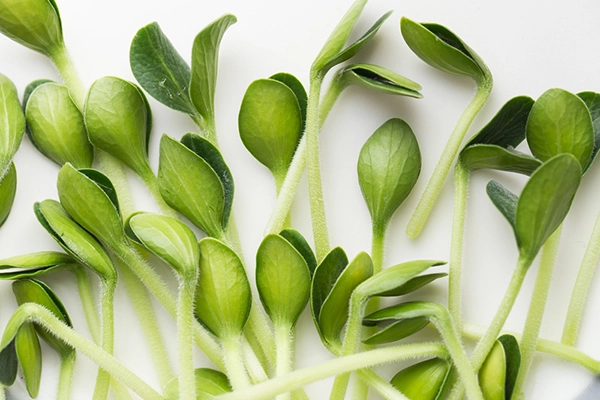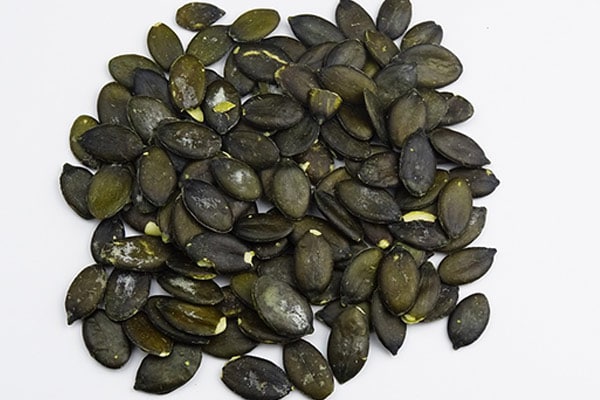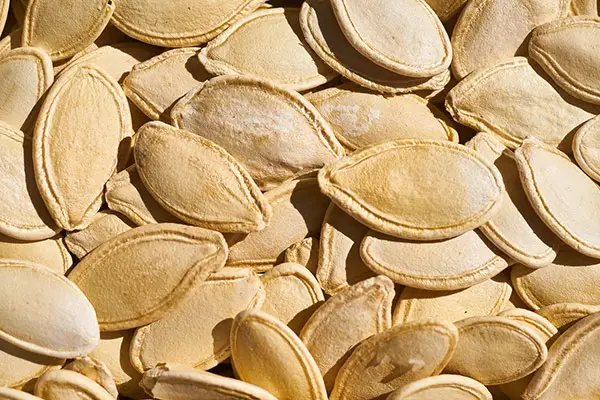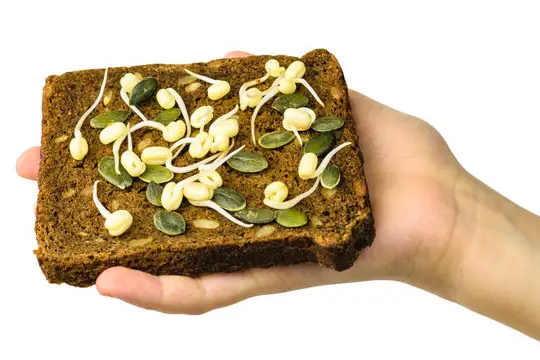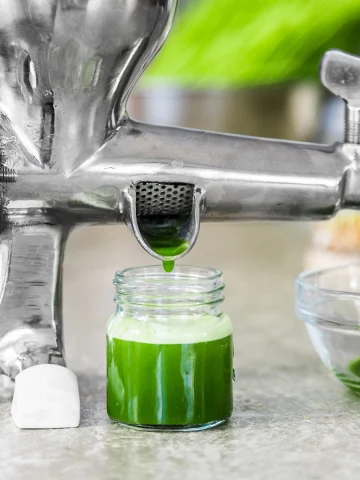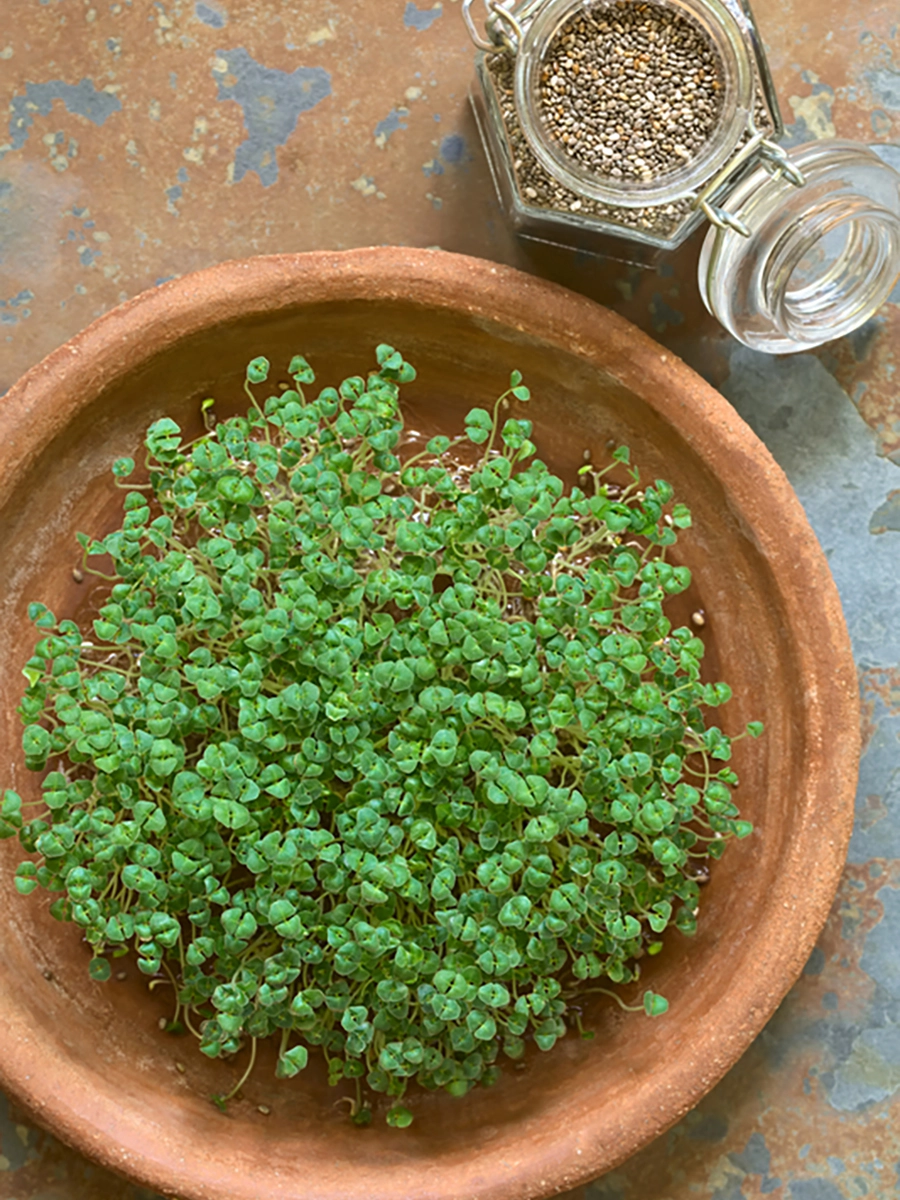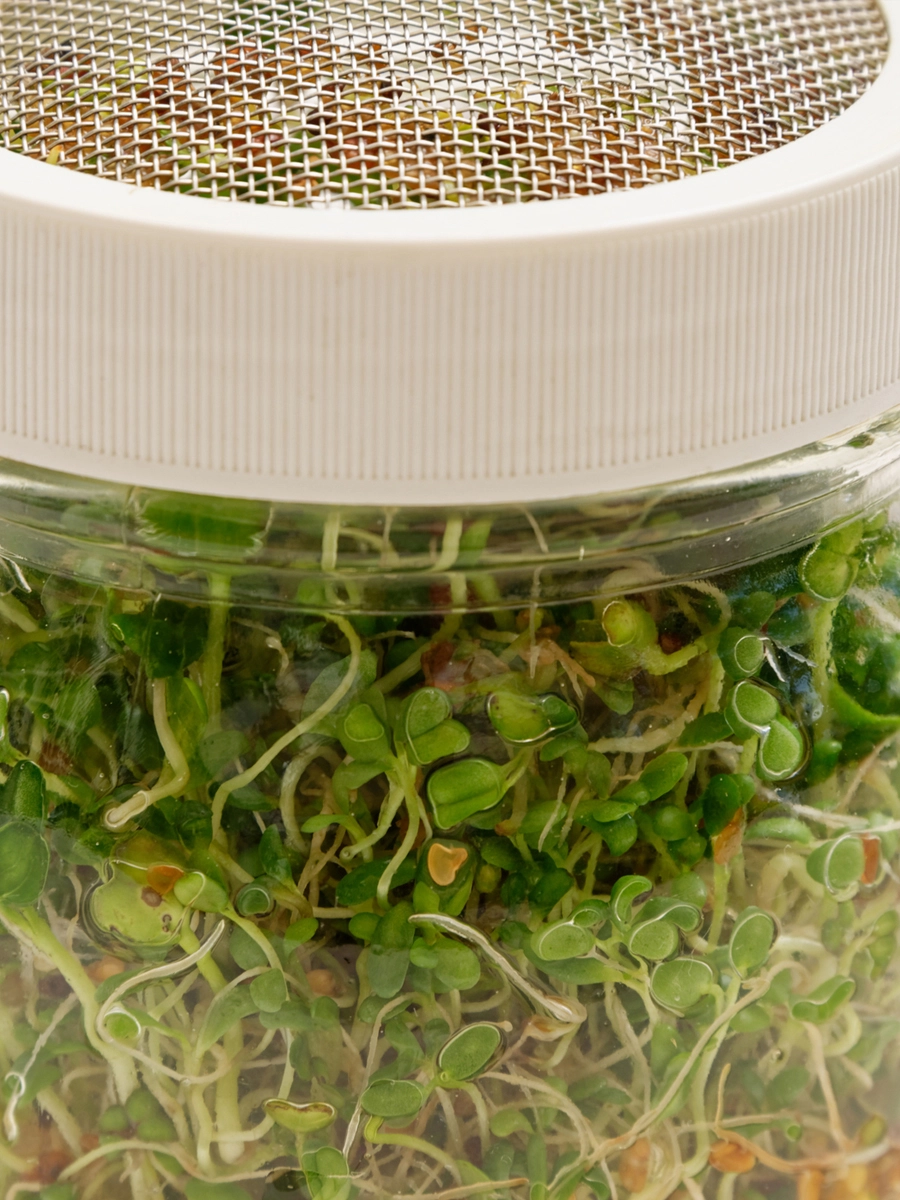How Do You Sprout Pumpkin Seeds?
Wondering how to sprout pumpkin seeds for eating? It's effortless, and I'll show you how in this quick sprouted pumpkin seeds recipe - all you need are pumpkin seeds, a jar, and some cheesecloth.
Jump to:
The best pumpkin seeds to use for sprouting are hulled or naked pumpkin seeds.
You don't need special equipment: a large glass jar, cheesecloth, and an elastic band will do the trick. I actually have a seed sprouter which is a tiered system where the water drips down through different levels, but it's not essential. You can grow great sprouts in just a jar.
- First, place the pumpkin seeds in a large glass bowl or jar, add Celtic sea salt, and filtered water. Soak for 1 – 2 hours.
- Drain and rinse the seeds thoroughly and put them back in the jar. let sit upside down for 8 – 12 hours. Cover the jar with a cheesecloth to keep bugs and dust out.
- Rinse the seeds and lay them flat on a rack or pan to dry. When they are dry, store in a glass jar in the refrigerator. For the best flavor and freshness, enjoy them immediately.
- Add pumpkin sprouts to salads, wraps, sandwiches, rice, curries, sandwiches, burgers… Anything!
How long does it take pumpkin seeds to sprout?
The entire process of sprouting pumpkin seeds takes between 2 - 3 days. It's a quick process that will leave you with tasty, easy-to-digest seeds.
You'll know the seeds have become sprouts visually and by taste. It is recommended to try the seeds after each rinse until you have the desired flavor. You may see a tiny sprout on the tip of the seed, but it's unnecessary to see this before they're ready.
What kind of pumpkin seeds do you use for sprouting?
Organic, Raw, Heirloom
Unpasteurized
Oregon Grown Pumpkin Seeds
Last update on 2025-05-18 / Affiliate links / Images from Amazon Product Advertising API
Hulled or naked pumpkin seeds are the best pumpkin seeds for sprouting. Both are easily found online.
In case you're wondering, there is a difference between the two options. Hulled seeds arrive sans shell as someone or a machine has shelled them before packing and shipping.
Naked pumpkin seeds grow without a shell on them, so they are ready to eat once they have grown. Since these seeds are ready to eat so quickly, they're called soaks instead of sprouts.
Try some ready-to-eat pumpkin seeds:
What are Soaks?
Soaks only need to be soaked for 1-2 hours, rinsed once, and left upside down to fully drain for 8-12 hours.
They can be rinsed and drained 1 - 2 more times (but not soaked) and then laid out flat to dry.
Once dry, you can eat them immediately or keep them in the refrigerator for up to eight hours. Soaks are for eating, not growing pumpkins.
What do sprouted pumpkin seeds taste like?
If you love the taste of regular pumpkin seeds, you'll love the sprouted version! They are scrumptious. They maintain their crunchiness but have a delicate and fresh flavor.
Sprouted pumpkin seeds are also easier to chop up as a bonus, so go ahead and add them to your salads!
Try These Easy Seed Sprouting Recipes:
Why eat sprouted pumpkin seeds?
Beyond the delicious taste they provide, they also offer many health benefits.
When you soak seeds, it activates the sprouting process, effectively breaking down much of the phytic acid and allowing the minerals, vitamins, fats, and proteins to be more readily absorbed.
Sprouting allows the digestion process to have a head start. Once the seeds are sprouted, they can be digested more efficiently by your body.
During the sprouting process, the seeds begin producing more nutrients as it tricks them into shifting to the plant growth stage. Of course, the seeds will need more nutrients to become a plant.
Because of this, there are even occasions where more nutrients are available in sprouts than in the plant version.
Pumpkin seeds are also high in magnesium, manganese, copper, and zinc. Magnesium is known for keeping bones strong, assisting with sleep, and keeping your brain healthy.
Zinc assists with immunity, and copper ties back into brain health. These are all essential nutrients that are easily found in pumpkin seeds.
What equipment do I need for sprouting seeds?
Sprouting seeds is a simple and fun way to grow fresh and nutritious sprouts at home. It requires very little equipment and can be done in just a few easy steps.
Here are the essential tools you'll need to get started with sprouting seeds:
- Sprouting seeds: The first and most important thing you'll need is the seeds themselves. Many different sprouting seeds are available, such as alfalfa, broccoli, radish, clover, and pumpkin seeds. You can find them at health food stores or online retailers. Be sure to choose seeds specifically labeled for sprouting, as they are free of harmful bacteria or contaminants.
- Sprouting jar: A sprouting jar is a typical canning jar. You can buy any brand, Mason or Ball. Both are easy, cheep, and are great options for sprouting seeds. It typically features a mesh or perforated lid that circulates air, preventing the seeds from spilling. You can also use a cheesecloth secured over the top with a rubber band.
- Water: Water is essential for sprouting seeds, so ensure you can access clean, filtered water. You'll need to rinse your seeds several times a day during sprouting, so having a nearby water source is helpful.
- Tray or dish: Once your seeds have sprouted, you'll need a tray or container to transfer them to for storage in the refrigerator. A shallow dish with a lid or plastic wrap will work well.
Optional Equipment:
- Sprouting lid: A sprouting lid fits over the top of your jar, making rinsing and draining your seeds much more accessible. It typically features a mesh or perforated design, allowing you to drain excess water quickly.
- Sprouting stand: A sprouting stand is a device that holds multiple sprouting jars at once. This can be useful if you plan to grow different types of seeds simultaneously.
- Sprouting Tray: A sprouting tray can be more convenient as you can sprout a lot simultaneously. Often designs will be stackable, allowing for a high yield from a small counter space area, unlike jars that will start filling up your kitchen.
- Sprouting Kit: A sprouting kit has plenty of room for bigger seeds like the pumpkin seed, and it contains four layers that can sprout many types of seeds and beans simultaneously. They are easy to use and compact.
Related: Sprout Huggers Silicone Lids Review
Sprouting seeds is a simple and enjoyable activity that requires only a few essential tools. With the right equipment, you can grow fresh, nutritious sprouts right in the comfort of your home. Happy sprouting!
Sprout Pumpkin Seeds
Notes
Materials Required:
- Clean cheesecloth, muslin cloth, or mesh lid
- A glass jar
- String or rubber band
Ingredients
- Hulled or Naked Pumpkin Seeds
- Celtic Salt
- Filtered Water
Instructions
- Rinse ⅔ cup of pumpkin seeds off well to get rid of dust from the hulling process.
- Add seeds, 1 ⅓ cup cool filtered water, and ½ teaspoon Celtic Sea Salt to a glass mason jar, then cover with a thin cloth. A mesh screen lid can also be used.
- Soak the seeds for 1-2 hours, then drain.
- Thoroughly rinse the seeds after draining.
- Add the seeds back to the jar and screw the mesh screen lid back on. Place the jar upside down at an angle (in a bowl works best). They will need partial light to "sprout." Make sure to keep the jar out of direct sunlight.
- Repeat rinse and drain process twice a day for one or two days.
- After one day, you should see your seeds turning into soaks. They will not fully sprout, but they will become "live."
- Give them a taste test, if you like them it is time to eat your tasty pumpkin seed sprouts.
- The live pumpkin seeds can also be refrigerated for 2-3 days before consumption.
- Add pumpkin sprouts to salads, wraps, sandwiches, rice, curries, sandwiches, burgers… Anything!

